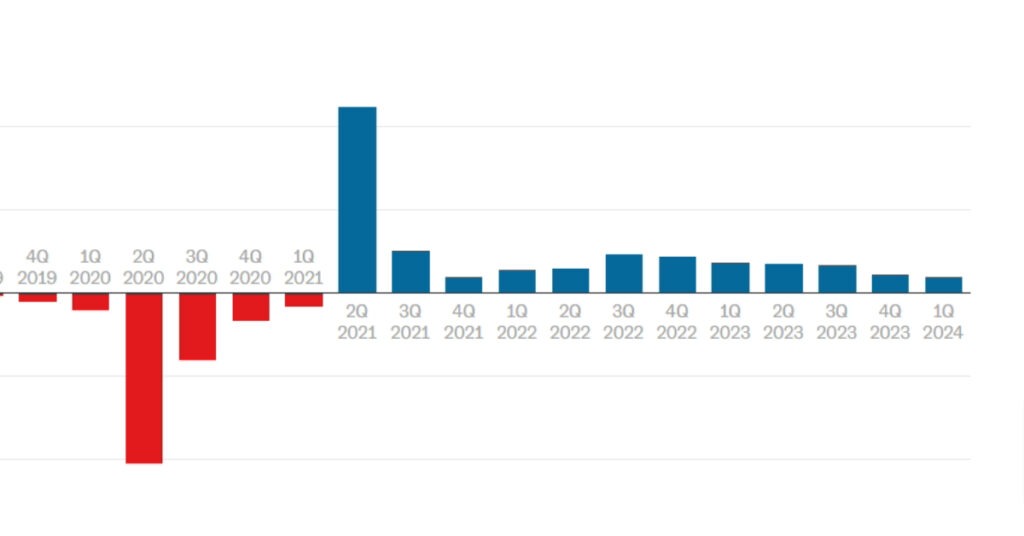In a shift from last year’s positive economic news, the Mexican economy is showing signs of a deeper slowdown than anticipated. Despite continued growth, recent data indicate a decline in momentum, leading experts to lower their growth forecasts for the country. The anticipated boost from increased government spending and heightened electoral campaign activities has fallen short of expectations.
This week, the International Monetary Fund (IMF) adjusted its growth outlook for Mexico downward for the second time, now projecting a 2.2% growth rate for the year. Similar revisions have been made by various analysis firms and investment funds, making the government’s target of 2.5% appear increasingly out of reach. This projection represents a deceleration from the 3.2% growth experienced in 2023. The decline in manufacturing production, reduced consumption, and a slowdown in the creation of new formal jobs are contributing factors. Additionally, the second half of this year is expected to be influenced by the weakness of the U.S. economy and the ongoing electoral process in the United States.
Janneth Quiroz, Director of Analysis at Monex, remarked, “There were high expectations that this year’s growth would be greatly benefited by the performance of the first half, considering that an increase in government spending was approved. In addition, we had a very large electoral process in June and it was expected that campaign spending would boost private consumption… that rebound did not occur.”
According to the latest data from the National Institute of Geography and Statistics (Inegi), the Gross Domestic Product (GDP) rose by 1.9% in the first quarter of the year compared to the same quarter in 2023. This marks the sixth consecutive quarterly slowdown, surprising analysts like Quiroz and her team, who had anticipated stronger activity in the first half of the year. “We realized that the economy did not follow the inertia it had had since 2022 and the first half of 2023. I think that once it reached its pre-pandemic size, we thought that we were already talking about more sustained growth and possibly we were still talking about a recovery,” Quiroz explained.
Data from the Mexican Social Security Institute (IMSS) reveals that formal employment grew by 2% year-on-year in June, but registered a 0.2% drop compared to the previous month. BBVA economist David Cervantes commented on this trend, stating, “This data confirms our expectation that formal employment would continue to slow down. Although we expect employment to regain some strength during the third quarter of the year, we continue to believe that it will continue to show a more moderate pace of growth compared to the previous year. This is due to the prevailing scenario of lower economic growth compared to previous years.”
Consumption has also seen a significant decline so far this year. Preliminary estimates by Inegi for June indicate a monthly drop, potentially influenced by rising prices for fruits and vegetables. General inflation reached 4.98% last month, the highest in years, with some foods experiencing price hikes of up to 130%, forcing many Mexicans to reduce their purchases.
Adverse weather conditions are partly responsible for these price increases. The central bank acknowledged at its last monetary policy meeting that the historic drought this year has reduced agricultural production, leading to higher prices. An analysis by Monex noted that fruit and vegetable prices have been growing at double-digit rates for seven months, and recent heavy rains and floods could trigger another supply shock.
As the second half of the year progresses, the focus shifts to the external sector. The United States, Mexico’s primary trading partner, has entered its own slowdown, evidenced by a 1.5% decline in manufacturing recorded in April. The reduction in demand for Mexican goods is a concerning trend.
While emerging trade barriers between the U.S. and China have sparked expectations of companies relocating to Mexico and injecting resources into the economy, investors remain cautious. Anti-Mexico rhetoric from leading U.S. presidential candidate Donald Trump has raised concerns about the future of the trade relationship between the two countries. Quiroz notes, “Our election and the U.S. election undoubtedly added uncertainty to decision-making.”
The outlook for Mexico’s economy remains uncertain as it navigates through these challenges, with the hope that external factors and domestic policies can eventually stabilize growth.
